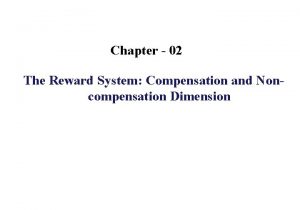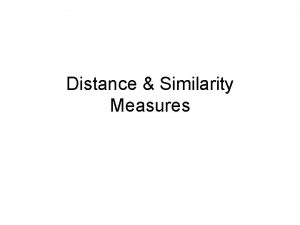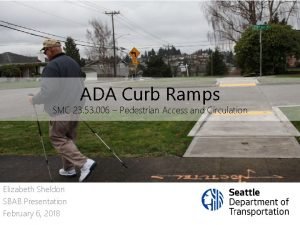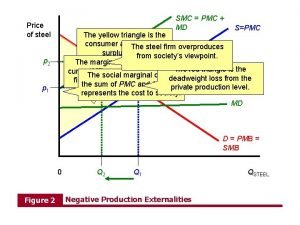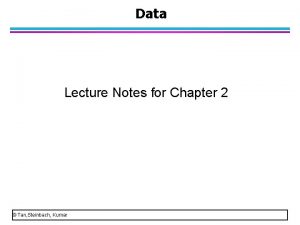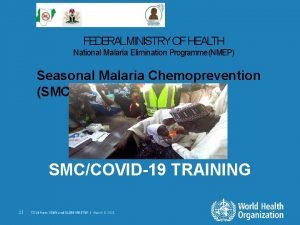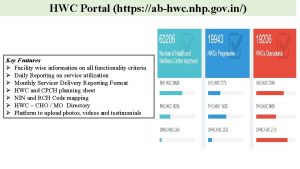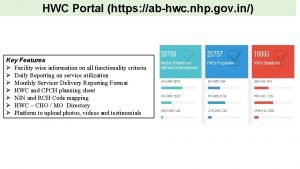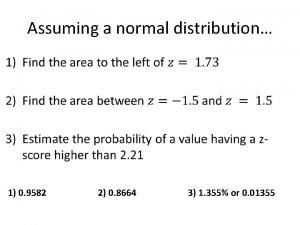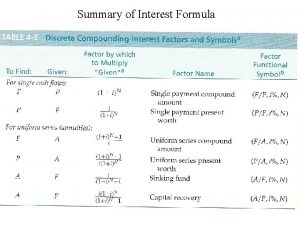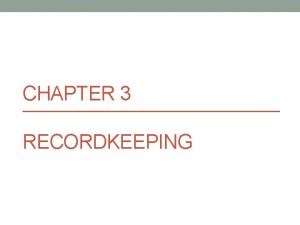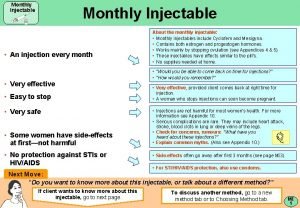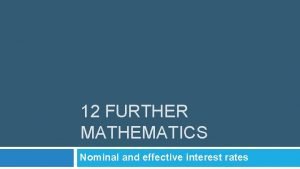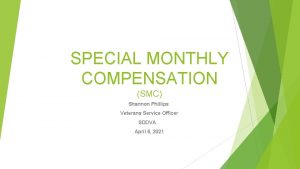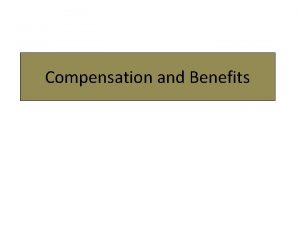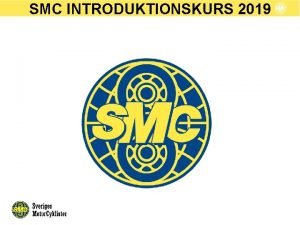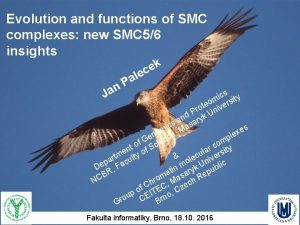Special Monthly Compensation Course Topics SMC K SMC
































































- Slides: 64

Special Monthly Compensation

Course Topics • SMC (K) • SMC criteria for Housebound and A&A • SMC for extremity losses at all levels (L thru O) • (P) elevations • Five ways to get to (O) • SMC (R) and (T) 2

What is Special Monthly Compensation? Special Monthly Compensation is a monetary benefit that is paid above and beyond the normal rating schedule to veterans that have certain service-connected disabilities or conditions. 3

References • 38 CFR 3. 350 • 38 CFR 3. 352 • 38 CFR 3. 552 4

Selected SMC Rates (Single Veteran no Children) (K) (S) (L) (O) (R 1) (R 2/T) $111. 74 per month, added on $3, 521. 85 per month $3, 915. 14 per month $5, 493. 95 per month $7, 850. 43 per month $9, 004. 64 per month • Effective December 1, 2020 5

SMC (K) Generally, SMC at the (K) rate is payable for loss of use of a single body part or loss of a single body function. The current rate (effective 12/2019) is $ 111. 74; this is added to the basic compensation rate. 38 CFR 3. 350(a) and 38 USC 1114(k) 6

SMC (K) is payable for: • • Loss or loss of use of one hand Loss or loss of use of one foot Blindness of one eye, having light perception Loss of use of both buttocks Bilateral Deafness Aphonia Loss or loss of use of a creative organ Breast loss (females only) 38 CFR 3. 350(a) 7

Loss of Use (LOU) of a Hand Loss of use of a hand will be held to exist when no effective function remains other than that which would be equally well served by an amputation stump at the site of election below the elbow with use of a suitable prosthetic appliance. 38 CFR 3. 350(a)(2)(i) 8

Loss of Use (LOU) of a Hand Effective remaining function is assessed on the basis of grasping and manipulation. Can the veteran pick up small objects such as paper clips or coins? Can he/she oppose the index finger to the thumb? Can he/she button clothing, open an envelope, or use a screwdriver? 9

Loss of Use (LOU) of a Hand Loss of use of a hand could also be established by a clinical finding of complete ankylosis of two major joints of an upper extremity. What is ankylosis? 3. 350(a)(2)(i)(a) 10

Loss of Use (LOU) of a Foot Similar criteria as for hand. No effective function remains other than that which would be equally well served by an amputation stump at the site of election below the knee, with the use of a suitable prosthesis. 3. 350(a)(2) 11

Loss of Use (LOU) of a Foot Effective remaining function is assessed with respect to the elements of balance and propulsion. Can the veteran raise the heel off the floor? Can he/she push off with the ball of the foot? 3. 350(a)(2)(i) 12

Loss of Use (LOU) of a Foot Loss of use of a foot could also be established by a clinical finding of: • Complete ankylosis of two major joints of a lower extremity • Shortening of a lower extremity by 3 ½ inches • Extremely unfavorable ankylosis of the knee • Complete paralysis of the external popliteal nerve (common peroneal) and consequent foot drop with characteristic organic changes. 3. 350(a)(2)(i)(a)and (b) 13

SMC (K) • The SMC (K) rate is added to any other SMC entitlement until the SMC level reaches SMC (O). • You can have more than one SMC (K) 14

SMC (K) • SMC (K) is payable for loss of use of a single extremity. • If another extremity also has loss or loss of use, the SMC for the pair of extremities is SMC (L) or higher. • The (K) no longer applies. 15

SMC (K) Example: Vet is rated for loss of one foot and receives SMC (K). If she later loses the other foot due to a service connected disability, she is entitled to SMC (L) instead of two SMC (K)’s. 16

SMC (S): Housebound Requires a single SC disability rated at 100% and either: An additional SC disability or combined disabilities independently ratable at 60 percent or more or The veteran is permanently housebound as a result of SC disabilities. 38 CFR 3. 350 (i) 17

SMC (S): Housebound The “single disability” must be one condition rated 100 percent. When a veteran has multiple conditions that combine to 100 percent but none is rated 100 percent by itself, housebound is not payable. 18

SMC (S): Housebound Example (100 percent plus 60 percent): PTSD rated at 100 percent and Hearing Loss rated at 60 percent would qualify for SMC (S). Example (Housebound “in fact”) The veteran is rated 100 percent for lung disease. He is on home oxygen and cannot leave home except to go to the doctor. He is medically confined to his home and therefore entitled to SMC (S). 19

SMC (S): Housebound Example 70% PTSD 60% Type 2 Diabetes Mellitus 20% Peripheral Neuropathy – Left Upper 20% Peripheral Neuropathy – Right Upper 20% Peripheral Neuropathy – Left Lower 20% Peripheral Neuropathy – Right Lower 10% Diabetic Retinopathy 10% Tinnitus The veteran is not confined to their home. Should SMC(S) be applied? 20

SMC (S): Housebound How about now? 70% PTSD –TDIU granted solely on this condition 60% Type 2 Diabetes Mellitus 20% Peripheral Neuropathy – Left Upper 20% Peripheral Neuropathy – Right Upper 20% Peripheral Neuropathy – Left Lower 20% Peripheral Neuropathy – Right Lower 10% Diabetic Retinopathy 10% Tinnitus The veteran is not confined to their home. Should SMC(S) be applied? 21

SMC (S): Housebound The 100% for SMC (S) can be based on individual unemployability, provided the TDIU rating is based on a single disability. See Bradley v. Peake, 22 Vet. App. 280 (2008) 22

SMC (S): Housebound SMC (S) can also be assigned on the basis of a temporary total evaluation under paragraph 28, 29 or 30. Example: A veteran requires 1 year of post-surgical convalescence for a service connected disability. If the other disabilities combine to 60% or higher, SMC (S) is payable during the Paragraph 30 time period. 23

SMC (L) and Higher SMC (L) and/or higher are awarded for: • Double extremity loss or loss of use (LOU) • Need for aid and attendance (A&A) • Blindness and Deafness 38 CFR 3. 350 24

SMC (L) for Aid and Attendance SMC (L) is payable when the veteran requires regular aid and attendance: • To perform activities of daily living (ADL) • To protect from the hazards of daily living • Includes being “bedridden” 38 CFR 3. 350(b) and 3. 352 25

SMC (L) for Aid and Attendance What are some ADL’s? • Dressing and/or Undressing • Cleaning/Bathing • Frequent adjustment of prosthetics needing the aid of another person • Feeding/preparing meals • Calls of Nature 38 CFR 3. 352(a) 26

SMC (L) for Aid and Attendance For SMC (L) based on need for A&A, a 100 percent rating is generally required. This includes multiple ratings for a “single disease entity” such as Parkinson’s or Multiple Sclerosis. Example: MS-related conditions: 80% Eye condition 70% Depression 40% Right upper extremity 30% Left upper extremity Combined is 100%. If the vet needs A&A, SMC (L) applies 27

SMC (L) for Aid and Attendance Example: 100% for Diabetes Mellitus 40% for left below the knee amputation (BKA) Vet needs A&A due to service connected Disabilities. SMC level is L plus K L for A&A K for BKA **Note that K entitlement can be used with L for A&A. 28

SMC for Double Extremity Loss The starting levels for SMC due to multiple extremity loss are as follows: • SMC (L) is payable for both feet • SMC (L) is payable for one foot and one hand • SMC (M) is payable for both hands 38 CFR 3. 350 (b) and (c) 29

SMC for Double Extremity Loss To understand the concept of building up SMC entitlement for greater losses, we need two ideas: 1. Elevating an SMC level by 1/2 steps 2. Joint Levels 38 CFR 3. 350 (b), (c), and (d) 30

SMC for Double Extremity Loss A one half step elevation means to increase the SMC level to the next higher rate or intermediate rate: e. g. from (L) to (L ½) or from (M ½) to (N). A full step elevation would be from (L) to (M) or from (N ½). (M ½) to The principle is that SMC is elevated ½ step per joint level per extremity. 38 CFR 3. 350 (b)-(f) 31

SMC for Double Extremity Loss Lower Extremity Joint Levels: Foot: Below knee amputation (BKA) or loss of use Knee: Above knee amputation (AKA) or loss of natural knee action with prosthesis in place. Hip: Amputation (only) so high as to prevent prosthesis Upper Extremity Joint Levels: Hand: Below elbow amputation (BEA) or loss of use Elbow: Above elbow amputation (AEA) or loss of natural elbow action with prosthesis in place. Shoulder: Amputation (only) so high as to prevent prosthesis 32

SMC for Double Extremity Loss of Natural elbow or knee action This means that the veteran does not have natural use of the joint, to the point that muscles affecting joint motion, if not already atrophied, will become so. Ankylosis or paralysis of the joint is entitling. 38 CFR 3. 350(c)(2) 33

SMC for Double Extremity Loss Examples of elevations based on multiple extremity loss: For a BKA on one side and an AKA on the other, the SMC (L) for both feet would be elevated ½ step for the knee level to SMC (L ½). For loss of a hand on one side and above elbow amputation on the other side, the starting level of SMC (M) would be elevated to (M ½) for the elbow level. 34

SMC for Double Extremity Loss 35

SMC (P) Elevations Elevation of SMC level under (P) For a veteran already rated at SMC (L) or higher, the following factors permit elevation of the SMC level. • Additional independent 50% disabilities= Half step • Additional independent 100% single disability = Full step • Triple extremity loss = Half step 38 CFR 3. 350(f)(3), (f)(4) and (f)(5) 36

SMC (P) Elevations Additional independent 50% disabilities A one half step elevation is provided for an additional single disability or combination of disabilities independently ratable as 50 percent or more. 38 CFR 3. 350 (f)(3) 37

SMC (P) Elevations ½ Step Examples: 1. 100 percent for bilateral BKA = SMC(L) 50 percent for PTSD SMC entitlement is now (L ½) 2. 100% for LOU of both hands = SMC(M) 30 percent for heart disease 30 percent for GI disorder SMC entitlement is now (M ½) 38

SMC (P) Elevations Additional independent 100 percent disability A full step elevation is provided if the veteran has an additional single disability independently ratable as 100 percent. Whole Step Example: 100 percent both hands 100 percent heart disease 0 percent creative organ SMC Entitlement is now SMC (M) Full step to SMC (N) Add SMC (K) SMC (N) + (K) 38 CFR 3. 350(f)(4) 39

SMC (P) Elevations The 50% (P) elevation permits a combination of disabilities but the 100% (P) elevation requires a single disability. 40

SMC (P) Elevations A veteran may only receive either the 50% or 100% (P) elevation NOT BOTH Example: 100% for both hands (LOU) SMC (M) 100 % heart disease Full step to SMC (N) 50% PTSD (No Change) 0% creative organ Add SMC (K) SMC entitlement is now SMC (N) plus (K) 41

SMC (P) Elevations (P) elevation for triple extremity Anatomical loss or loss of use, or a combination of loss and loss of use, of three extremities is entitled to a ½ step elevation. This elevation is in addition to SMC (K) entitlement and can be used with the 50 or 100 percent elevations. 38 CFR 3. 350(f)(5) 42

SMC (P) Elevations Triple Extremity Example: Both feet One hand (60%) plus (K) SMC (L) ½ for triple plus ½ for 50% (P) SMC entitlement is now SMC (M)+(K) NOTE: Loss or loss of use of a hand is ALWAYS rated at least 60 percent. 43

SMC (P) Elevations Triple Extremity Example: 1. Both hands One foot (40%) (M) ½ for triple plus (K) SMC entitlement is now SMC (M ½) + (K) 2. Both hands One foot (40%) 100% Heart Disease (M) ½ for triple plus (K) Full step (P) elevation SMC entitlement is now SMC (N ½) + (K) 44

SMC (P) Elevations with Aid and Attendance For SMC (L) based on A&A, the (P) elevations under 3. 350 (f)(3) and (f)(4) are permitted. The (L) can be elevated a half step for an additional 50 percent evaluation. The (L) can be elevated a full step for an additional, single 100% disability. 45

SMC (P) Elevations A&A Example with P Elevation: 100% for Diabetes Mellitus 50% for Migraines 40% for left BKA Vet needs A&A due to diabetes. 100% with A&A ½ for additional 50% condition BKA (L) (L½) (K) SMC entitlement is SMC (L ½)+(K) 46

SMC (O) There are 5 ways to get to SMC (O): • Both arms, shoulder level amputation • Paraplegia with loss of bowel and bladder sphincter • Conditions entitling to two SMC codes rated (L) to (N) • Elevations under (P) • Blindness and deafness 47

SMC (O): Paraplegia with loss of bowel and bladder sphincter control Paraplegia (paralysis of both lower extremities) together with loss of anal and sphincter control entitles the veteran to SMC (O), even though incontinence has been overcome under a strict regimen of rehabilitation of bowel and bladder training and other auxiliary measures such as a bowel management program. Bowel management program: Overcoming the inability to void the bowel using medical or artificial means such as laxatives & digital stimulation. 38 CFR 3. 350(e)(2) 48

SMC (O): Conditions entitling to two SMC codes rated (L) to (N). Must be separate and distinct disabilities but can be losses resulting from a common etiological agent, for example, one injury or rheumatoid arthritis. 38 CFR 3. 350(e)(1)(ii) 49

SMC (O): Conditions entitling to two SMC codes rated (L) to (N). Examples: 1. 100% LOU Hands SMC (M) 100% LOU Feet SMC (L) SMC entitlement is SMC (O) 2. 100% Hands 100% Psychosis requiring A&A SMC entitlement is SMC (O) SMC (M) SMC (L) 50

SMC (O): Elevations under (P) to the (O) level. Example: 100% Both legs, hip level amputations SMC (N) 100% PTSD Full step (P) SMC entitlement is now SMC (O) 51

SMC (O): Blindness and Deafness Bilateral service connected hearing loss rated at 60% or more disabling in combination with service-connected blindness with bilateral visual acuity 20/200 or less. Or Service-connected total deafness in one ear or bilateral deafness rated at 40% or more disabling in combination with serviceconnected blindness of both eyes having only light perception or less. 38 CFR 3. 350(e)(iii) and (iv) 52

SMC (O) Once a veteran is entitled to SMC (O), SMC (K) no longer applies There is no SMC (O ½) or SMC (O)+(K) 38 CFR 3. 350(a) 53

SMC (R) Eligibility for SMC (R) 1. Requires A&A And 2. Meets one of two threshold levels: • SMC (O) • SMC (N ½) plus (K) 38 CFR 3. 350(h)(1) and (2) 54

SMC (R) Eligibility for SMC (R) Examples: 1. 100% Both legs, hip level amputations SMC (N) 50% PTSD SMC (N½) 0% Loss of creative organ SMC (K) If the vet needs A&A SMC level will be elevated to SMC (R) 2. 100% Both hands above elbow amputation SMC (N) 100% Heart Disease SMC (O) If the vet needs A&A SMC level will be elevated to SMC (R) 55

SMC (R) • SMC (R) is based on a factual need for A&A under 38 CFR 3. 352, the same criteria for SMC (L) based on A&A. • SMC (R) can be payable even if A&A was a partial basis of the rate under SMC (O) or SMC (P). • In other words, even if the A&A was used to determine SMC (O) entitlement, it can also be used to determine SMC (R) entitlement. NOTE: SMC (R) is only paid when the veteran is not hospitalized at the government’s expense. 38 CFR 3. 350(h)(1) and (2) 56

SMC (R) • The SMC (R 1) rate is paid unless the veteran meets the specific requirements for SMC (R 2) • (R 2) is only provided when a higher level of care is required to prevent institutionalization. • If a veteran who is receiving SMC (R 2) is hospitalized, the rate is reduced to SMC (R 1). • If a veteran is receiving SMC (R 1) or (R 2) and is hospitalized at the government’s expense, the rate will be reduced to SMC (O) 38 CFR 3. 352(b)(1) and (2) 57

SMC (R) SMC (R 2): Higher Level of Care to Prevent Institutionalization • Entitled to (R 1) • Without higher care, the veteran would be institutionalized. • Need must be certified by a physician. 38 CFR 3. 352(b) 58

SMC (R) SMC (R 2) Higher Level of Care Criteria: • Skilled services (e. g. PT, injections, indwelling catheter, sterile dressing, etc. ) • Performed in the person’s home • Daily • Performed by a licensed health care provider or by a person under regular supervision of a LHC professional (Can be a relative) 38 CFR 3. 352 (b)(2), (3), and (4) 59

SMC (T) is equal to the (R 2) rate and is payable for veterans who: • Need regular A&A for residuals of traumatic brain injury (TBI), AND • Would require hospitalization, nursing home, or other residential institutional care in the absence of regular in-home A&A 38 CFR 3. 350(j) 60

SMC (T) • SMC (T) is not payable if the veteran is otherwise eligible for SMC (R 2) • If a veteran receiving SMC (T) is hospitalized the rate is reduced to SMC (S) plus any applicable (K’s) 61

Ancillary Benefits Most veterans who qualify for SMC will also qualify for additional ancillary benefits such as: • • Specially Adapted Housing (SAH) Special Home Adaptation (SHA) Temporary Residence Adaptation (TRA) Automobile Allowance Adaptive Equipment for Auto Commissary Card Dependent Education Dependent Healthcare Always talk to your veterans to determine if any claims for ancillary benefits should be filed 62

Final Thoughts • Special Monthly Compensation is paid to veterans whose injuries are more severe than the rating schedule reflects • Remember to look for SMC entitlement when reviewing ratings (especially SMC (K)) • There can be eligibility to multiple SMC (K)’s but once the vet reaches SMC(O) they no longer apply • A SMC (P) elevation can only be used once per veteran • SMC can be applied during temporary rating periods (4. 28, 4. 29, 4. 30) 63

Final Thoughts • Don’t expect to master SMC in a day • Always use your references • If you have any questions once you return to your office, please ask!! 64
 Compensation and non compensation dimensions
Compensation and non compensation dimensions Special investigative topics 3232
Special investigative topics 3232 Dena schlosser
Dena schlosser Software engineering course syllabus
Software engineering course syllabus Similarity and dissimilarity measures in data mining
Similarity and dissimilarity measures in data mining Smc ptk
Smc ptk Smc scholars classes
Smc scholars classes Smc 23
Smc 23 Smc technology sdn bhd
Smc technology sdn bhd Student disability services (sds) office
Student disability services (sds) office Smc
Smc Smc pmc
Smc pmc Smc vs jaccard
Smc vs jaccard Chm tool
Chm tool Smc andromeda
Smc andromeda Smc house marking
Smc house marking Smc tool
Smc tool Mass effect title
Mass effect title H. amano
H. amano Course title and course number
Course title and course number Course interne course externe
Course interne course externe Header bond t junction
Header bond t junction In khosla's formula monthly losses is calculated as
In khosla's formula monthly losses is calculated as Icici pru pinnacle super lp fund value
Icici pru pinnacle super lp fund value Safety margin ratio
Safety margin ratio Pmiu monthly school report
Pmiu monthly school report Nhs pension examples
Nhs pension examples The minimum monthly payment for janet's credit card is 2%
The minimum monthly payment for janet's credit card is 2% Ab-hwc.nhp.gov.in login
Ab-hwc.nhp.gov.in login John and marcia monthly spending plan 1 answer key
John and marcia monthly spending plan 1 answer key Whats semi monthly pay
Whats semi monthly pay Monthly planner 2010
Monthly planner 2010 Annual retail trade survey
Annual retail trade survey Housekeeping monthly may 1955
Housekeeping monthly may 1955 Ecmwf monthly forecast
Ecmwf monthly forecast Monthly digital reporting
Monthly digital reporting Monthly flexible manufacturing budget
Monthly flexible manufacturing budget Ommaverify.ok.gov
Ommaverify.ok.gov Monthly mpr
Monthly mpr Htt //ab-hwc.nhp.gov.in
Htt //ab-hwc.nhp.gov.in Thomson reuters
Thomson reuters Monthly operational review
Monthly operational review Monthly marketing report
Monthly marketing report Monthly cash flow plan dave ramsey
Monthly cash flow plan dave ramsey Interesting sabbath school topics
Interesting sabbath school topics The monthly utility bills in a city have a mean of $70
The monthly utility bills in a city have a mean of $70 Discrete compounding formula
Discrete compounding formula Monthly report introduction
Monthly report introduction Monthly digital reporting
Monthly digital reporting Closing stock journal entry
Closing stock journal entry Effective rate
Effective rate Monthly marketing report
Monthly marketing report Last day email
Last day email Monthly expansion factor formula
Monthly expansion factor formula Section 3-3 using a budget answers
Section 3-3 using a budget answers Sun life monthly payment
Sun life monthly payment Rafiq's monthly mortgage payment
Rafiq's monthly mortgage payment Sabbath school promotional talk about investment
Sabbath school promotional talk about investment Mdm daily sms format
Mdm daily sms format Monthly gantt
Monthly gantt Cfsv2 monthly prec anomalies
Cfsv2 monthly prec anomalies Monthly injection
Monthly injection The guidelines for the monthly
The guidelines for the monthly Effective monthly interest rate
Effective monthly interest rate Nhmis registers
Nhmis registers
